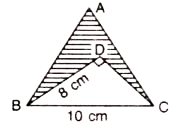Determine whether the triangle whose lengths of sides are 3 cm, 4 cm,5 cm is a right-angled triangle.
To determine whether the triangle with side lengths of 3 cm, 4 cm, and 5 cm is a right-angled triangle, we will use the Pythagorean theorem. The theorem states that in a right-angled triangle, the square of the length of the hypotenuse (the longest side) is equal to the sum of the squares of the lengths of the other two sides.
1. Identify the sides of the triangle:
- The sides are given as 3 cm, 4 cm, and 5 cm.
- We will identify the longest side, which is the hypotenuse. Here, the hypotenuse is 5 cm.
2. Apply the Pythagorean theorem:
- According to the theorem, for a triangle to be a right-angled triangle, the following equation must hold:
(side 1)2+(side 2)2=(hypotenuse)2
- In our case, we can take side 1 as 3 cm and side 2 as 4 cm.
3. Calculate the squares of the sides:
- Calculate 32:
32=9
- Calculate 42:
42=16
- Calculate 52:
52=25
4. Sum the squares of the two shorter sides:
- Now, add the squares of the two shorter sides:
32+42=9+16=25
5. Compare with the square of the hypotenuse:
- We found that:
32+42=25
- And we also calculated:
52=25
- Since 25=25, the equation holds true.
6. Conclusion:
- Since the Pythagorean theorem is satisfied, we conclude that the triangle with side lengths 3 cm, 4 cm, and 5 cm is indeed a right-angled triangle.
- The sides are given as 3 cm, 4 cm, and 5 cm.
- We will identify the longest side, which is the hypotenuse. Here, the hypotenuse is 5 cm.
- According to the theorem, for a triangle to be a right-angled triangle, the following equation must hold:
(side 1)2+(side 2)2=(hypotenuse)2
- In our case, we can take side 1 as 3 cm and side 2 as 4 cm.
- Calculate 32:
32=9
- Calculate 42:
42=16
- Calculate 52:
52=25
- Now, add the squares of the two shorter sides:
32+42=9+16=25
- We found that:
32+42=25
- And we also calculated:
52=25
- Since 25=25, the equation holds true.
- Since the Pythagorean theorem is satisfied, we conclude that the triangle with side lengths 3 cm, 4 cm, and 5 cm is indeed a right-angled triangle.
Topper's Solved these Questions
- THE TRIANGLE AND ITS PROPERTIESBOOK - NCERT ENGLISHCHAPTER - THE TRIANGLE AND ITS PROPERTIESEXERCISE - EXERCISE 6.4
6 Videos
- THE TRIANGLE AND ITS PROPERTIESBOOK - NCERT ENGLISHCHAPTER - THE TRIANGLE AND ITS PROPERTIESEXERCISE - EXERCISE 6.5
8 Videos
- THE TRIANGLE AND ITS PROPERTIESBOOK - NCERT ENGLISHCHAPTER - THE TRIANGLE AND ITS PROPERTIESEXERCISE - EXERCISE 6.2
2 Videos
- SYMMETRYBOOK - NCERT ENGLISHCHAPTER - SYMMETRYEXERCISE - EXERCISE 14.2
2 Videos
Similar Questions
Knowledge Check
A triangle whose sides are of length 12 cm, 14 cm and 18 cm is called a
AScalene triangleBEquilateral triangleCRight angles triangleDIsosceles triangle
Can a triangle have three sides whose length are
3 . 4 cm, 4 . 7 cm, 8 cm ?
View SolutionFind the area of a triangle whose sides are 3cm, 4cm and 5cm respectively.
View SolutionFind the area of the triangle whose sides are 50 cm , 48 cm and 14 cm .Find the heigth of triangle corresponding to the side measuring 48 cm .
View SolutionCan the lengths 30 cm, 32 cm, and 16 cm be the dimensions of a right-angled triangle ?
View SolutionCan a triangle have three sides whose length are
2 . 5 cm, 4 . 5 cm , 8 cm ?
View SolutionThe given figure shows an equilateral triangle ABC whose each side is 10 cm and a right-angled triangle BDC whose side BD = 8 cm and ∠D=90∘. Find the area of the shaded portion.

View SolutionFind the perimeter of a triangle whose sides are 7 cm, 5.4 cm and 10.2 cm long,
View Solution
